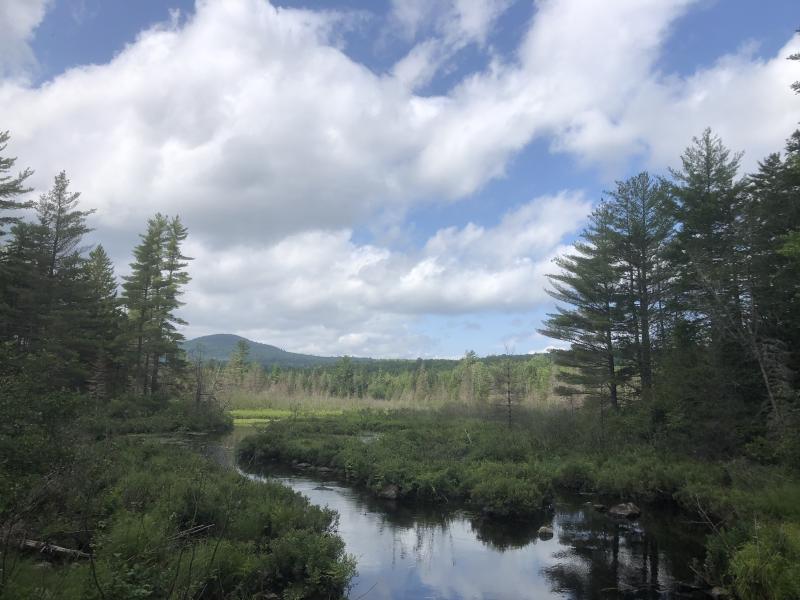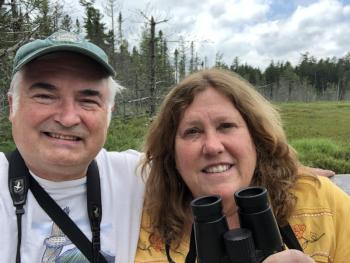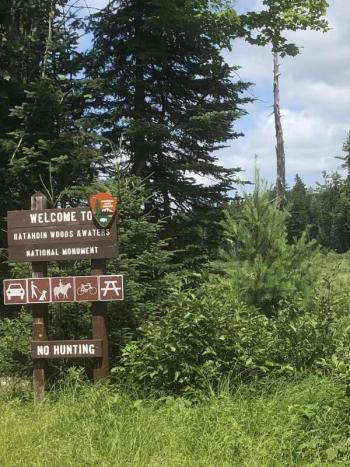Quiet.
Deep, profound quiet.
A quiet, unbroken by low grumbling of distant traffic or the white noise of an overhead jet. No buzzing lawnmowers or sirens. No dogs barking or brakes screeching.
That was what we experienced this past late-July weekend in parts of the Katahdin Woods and Waters National Monument as we gazed across beautiful scenes of forests, mountains, ponds, and stream. It was wonderfully regenerative and calming.
Of course, it was not always completely and absolutely silent, and that’s a good thing. The last singing birds of summer were evident in various places. We heard red-eyed vireos, one of the late singers of summer, in the forest as we explored the many miles of dirt roads in the KWW National Monument. A scarlet tanager sang its “robin with a sore throat” song from one spot along Swift Brook Road. The loud “teacher-teacher” of an ovenbird floated on the air near Mink Frog Pond as we breathed in the sweet smells of pines and spruce. The haunting songs of hermit thrushes echoed from a number of places.
Farther on, near the beginning of the Loop Road, we stopped off at Lynx Pond. Here, we strolled through the mossy woods on a short trail to a beautifully situated deck overlooking the pond. A breeze blowing across the pond and the boggy sphagnum mat surrounding the edge seemed to bring the air temperature down by a few degrees like a natural air conditioner. A swamp sparrow sang a desultory trill from across the water. Overhead, two white-winged crossbills flew by giving their distinctive telegraph calls: “dit-dit, dit-dit-dit.” We were pleased to hear in the distance the “che-bunk” songs of several yellow-bellied flycatchers, no doubt lurking in the dark, cool shadows of the spruces. The prominent “pip, pip, pip” of another northern forest specialty bird, the olive-sided flycatcher, carried in from somewhere to the west, seemingly close enough that we should be able to spot it at the top of a tall tree. Instead, we had to be content enjoying only its voice across the unbroken woods.
We were surprised to flush a red-shouldered hawk as we drove along the road, rather than the more expected broad-winged hawk. A chimney swift zipped by on rapidly beating wings—we had to assume that it was likely nesting in a hollow tree as its ancestors did before humans arrived in North America and built the chimneys that are the preferred nesting site for most chimney swifts.
We’ve written about this amazing place in past columns and recounted our stories of seeing bears and moose and many of the special birds of boreal forests there including black-backed woodpeckers, boreal chickadees, and Canada jays, among others. This trip was short and not at the optimal date and time of day for finding such birds. But the stunning beauty, the healing quiet, and the birds that we did see and hear were more than enough to make it worth the visit.
A new visitor center will welcome people here next spring. It has been designed in partnership with Wabanaki Advisory Board and will be an incredibly beautiful and unique experience for visitors at any time of year. Friends of Katahdin Woods and Waters is working on the final fundraising push for a capital campaign for the center and for some other needs. You can check out the opportunity to support this work here: https://www.friendsofkww.org/a-monumental-welcome/
Jeffrey V. Wells, Ph.D., is a Fellow of the Cornell Lab of Ornithology and Vice President of Boreal Conservation for National Audubon. Dr. Wells is one of the nation's leading bird experts and conservation biologists. He is a coauthor of the seminal “Birds of Maine” book and author of the “Birder’s Conservation Handbook.” His grandfather, the late John Chase, was a columnist for the Boothbay Register for many years. Allison Childs Wells, formerly of the Cornell Lab of Ornithology, is a senior director at the Natural Resources Council of Maine, a nonprofit membership organization working statewide to protect the nature of Maine. Both are widely published natural history writers and are the authors of the popular books, “Maine’s Favorite Birds” (Tilbury House) and “Birds of Aruba, Bonaire, and Curaçao: A Site and Field Guide,” (Cornell University Press).






























